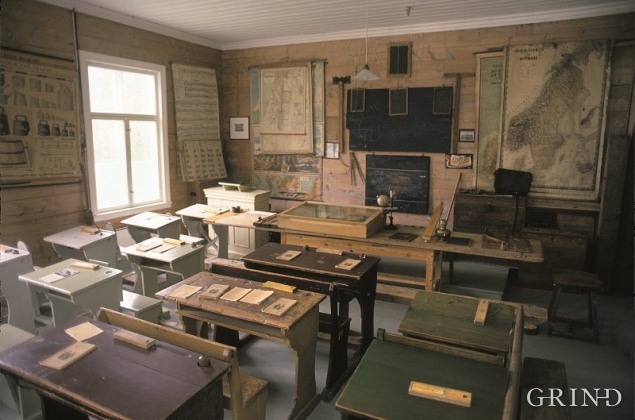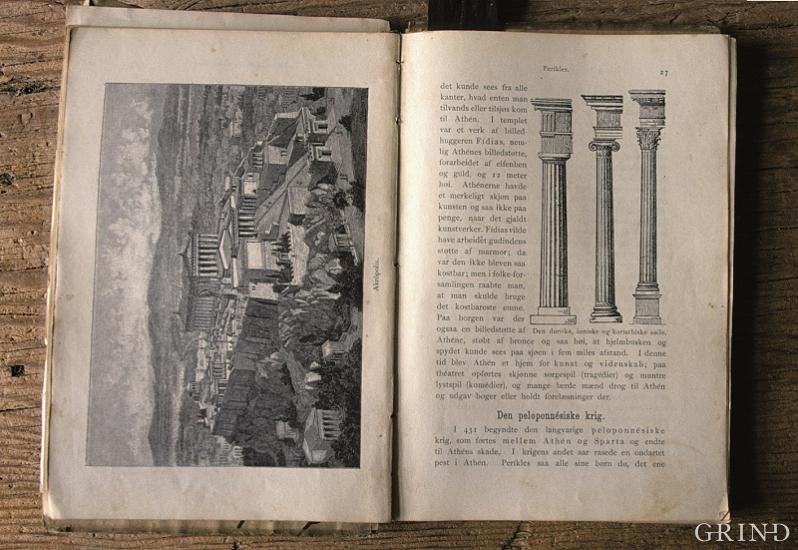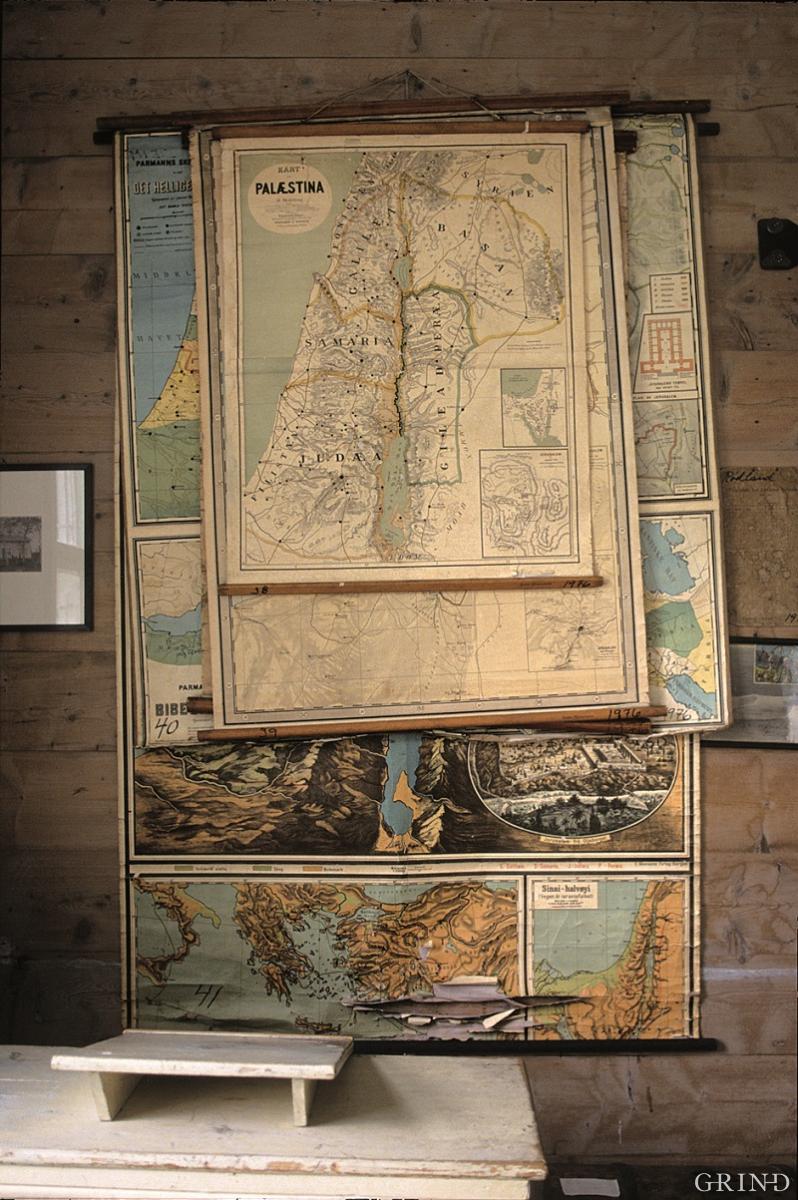Published: 19.05.2009 | Author: Asbjørn Tveiten
Classroom (Lindås school museum Helge Sunde).
A WINDOW ON THE WORLD
The little white painted school house, the village school, often set between knolls and little woods in the outer fields, placed as centrally as possible between the farms that made up the school district, is the key symbol of the education society, a principal cultural factor. Most of these schoolhouses were built after 1860 and took over from the ambulatory school, when the teacher travelled from house to house and taught all the children in the hamlet. And when the school became more of an institution, educational work also gained a firmer foundation. Through Nordahl Rolfsen’s reader, Norway was united into one nation. Nordahl Rolfsen, a native of Bergen, was the heir of Harald Hårfagre With his fine story-teller style and sense of imagery, he gave meaning to the concept of the nation. Bernt Støylen, the rector of the teaching college and tutor of priests added dialect to the books and so they were also able to relate to the rural districts. Had Støylen perhaps not himself been a fisherman, been converted at Kvinnherad and been editor of the Norwegian Children’s Magazine? Sound and homely all of them. With the textbook the journey went from rural Norway with broom and enterprise; which in the city was turned into factories and goods for export; which sailed on Norwegian ships on all the seas, to foreign cultures and tropical climes. It opened up a window to the world for everyone, a way out for the smart ones, and the vision of a new nobility in the homestead built on hard work and good will.
The school as a cultural factor
Building of the many village schools tell us that the school had become more important in local society. It was often the only cultural institution in the village. When the teacher was master in his own schoolhouse, it gave the teaching profession a higher status. The old teacher training could be so variable. The very ideal of a teacher for Norwegians down the generations, Bård the schoolmaster, was a corporal who “Would order something …. and then would claim to be a teacher”. But from the 1890s and onwards, the most usual route for teachers was through a Christian teachers’ training school, or the liberal college of the teachers’ training school in Volda or at Stord. Respect for Christianity and the Christian cultural foundations was inherent in most people, and the school formed the basis for people’s values and ethics.
The school and the popular movements
Now and then tensions developed between the chapel folk and those who belonged to the liberal youth house. There could be collisions on different outlooks on life and conflicts on cultural questions. The teacher and the school did not stand aside from the village and the tensions which reigned within local society, but were right in the middle of it. Nonetheless the school promoted an understanding of reality and an ethical responsibility which rural people were in agreement with.
There were tendencies towards populism in both the pietistic movement and in the liberal Grundtvig movement. On election day the teacher put on morning dress and went to the polling station and voted for the Left party (Venstre). It is a particularly Norwegian phenomenon that the teachers were leaders of political liberalism. And rural teachers were by no means inactive in rural politics. It was a different matter for women teachers. Up until the First World War there was a sizeable contribution of city women from the higher social classes amongst those who went to teachers’ training college. In the rural areas they did not have the same position as the men teachers, neither in the schools not in politics. The School Newspaper thought that “these Bergen girls really benefit from some years in the countryside”. It was not really meant as a positive testimony.
The teacher, the sexton and the Left Party politician were also members of the New Norwegian language movement and to the temperance movement. This is the “ideal type” portrayed from the beginning of the 20th century and onwards, both by those who described him sympathetically, and by those who caricatured him. He was a person who identified himself with the democratic background he came from, and was active in forming the cultural profile in the rural areas. He was not responsible for those who represented upper-class culture, but for his fellows and equals within the rural environment. He was often the best educated amongst them. Leadership in the language society, the temperance society, the missionary society, the youth society, the singing society and the history society contributed to his status. The rural teacher was thus not much affected by the discontent with status which affected teachers in many other countries, and in our own country in recent decades.
A meeting with the literary culture
The Norwegian language was ranked next to Christian instruction. At times the readers could be the only books which the school provided for free.
These gave the pupils an encounter with Norwegian poets and painters and provided knowledge on natural history, history and society. Around 1870 there was sharp conflict about the first adventure stories and fictional tales in the reading books in many of the rural districts of Hordaland. Later on many people have viewed this as narrow-minded. But fewer people have reflected on how it must have been to have a fictional culture foisted on them, for parents who toiled from morning to night to keep famine and need at bay. The children were needed so much to help them in this. But the powers-that-be wanted the children to sit in a classroom and laugh at worldly tales and pointless adventure stories. Some school reformers surely had more foresight and vision than practical judgement.
In the struggle to introduce a national language, New Norwegian, into the schools, the teachers were often those who took the initiative. Modalen and Eksingedalen were the first rural districts in the country to go over to using New Norwegian as a language of instruction in 1890. In the decade which followed, the language gained acceptance in almost every district in the county. It was a legitimisation of the “people’s language”, the very core of the cultural movement in the rural areas which the School Law of 1889 made way for. The whole of the National School Law was based on a decentralised way of thinking, linked to the concept of a popular, Christian basis for education. The domestic popular poetical works could appear in the inspiring company of traditional poetry in the whole Indo-European culture.
Reading societies and popular instruction
Very early on we find teachers taking the initiative to start up reading societies; in Sunnhordland as early as the 1820s. Some teachers made up small collections and teaching books. Pupils and other rural folk came to many teachers’ homes to borrow books from the teachers’ own collections. Well into the 20th century collections of schoolbooks increased in many schools. The New Norwegian language society could risk offering to pay half the subscription for schoolchildren who subscribed to the “Norwegian Children's Newspaper” (a newspaper written in New Norwegian). This was an opening towards a new and different culture than they had known from before, a literary, historical and scientific culture. Many a lad devoured “Round the World by Submarine” and experienced Jules Verne’s fertile imagination in “sound, traditional Norwegian linguistic garb”.
Knowledge creates change
“Please do not spit on the floor”- the words shone out on a whiteboard on the wall of the classroom, signed by the local medical society’s – or the health society’s as it was known - red sign. This was from the time when the spitters had been driven out of the schoolhouse by eager health information folk. The teacher was one of them. He sold the magazine “Life and Health” on subscription, not without a thought for how the parents would take it. He turned up at the big health bazaar in the chapel. The bucket of water with the ladle from which all the pupils drank had been removed from the classroom - was that not some time in the 1930s? In the tough war years, the teacher dished out cod-liver oil to everyone in the lunch break. The cod-liver oil bottle had its place on the shelf which otherwise housed the inkwells and the bibles. There stood also the egg cups the pupils drank the health drink from. They were washed every holiday. Cleanliness demanded its share.
In the 1930s many municipalities introduced medical checks of the pupils, whilst Bergen had been early with this. The doctor came with his stethoscope and listened to the chest and administered the Pirquet test (for tuberculosis). Tuberculosis was the great threat. Far too many children had the experience of seeing consumptive fellow-pupils die at a very early age. The midwife or other appropriately qualified women had for a long time vaccinated children against smallpox epidemics. And in the hygiene textbooks the children could see in black and white how sickness flowed from the dung heap into the neighbour’s well. This was how the school participated with an extended, collective social responsibility.
When the school failed
At the same time the school was a place for branding and for exclusion - especially where the teacher failed. From the 1890s onwards there was an inspection board where the parents were in the majority but they hardly engaged themselves to any extent. Sometimes it was the poor who suffered. Sometime it was those who were slow in learning. The punishment corner was only found in the classroom, but everyone in the village knew who had been standing there. The most deviant could be sent off to special schools or institutions - and so the school could break up the sense of community which the villages had in good times. Some pupils struggle with dark thoughts about the school, and left it with bad memories, bent over in both spirit and soul.
But there is reason to believe that the stories of the cane and the belt have expanded somewhat afterwards. At least in the country school, and in the 20th century use of this type of punishment was viewed as failure on the part of the teacher, something that reduced his reputation. Even although it was usual for the parents to support the teacher in most of the matters relating to the children, respect in many instances was worn thin. The story of a school board where a whole generation grew up without being able to count is certainly a caricature, but there is always some truth in a caricature.
The conflict which bound folk together
The German occupation and the attempt at Nazification during the Second World War was a frontal attack on the values the school was built upon. In the decisive battle for minds and attitudes it was the teachers who were in the front line. They were to be the soldiers on the front line in the battle for the right of the parents to bring up their children, for freedom of conscience and freedom of organisation within society. In this position it was the teacher who was standing as the indomitable optimist. Nils Kvilekvål remembers the old country teacher’s friendly, ironic words:
“I don’t say this so that you shall take them out of the world but so that you shall look out for evil, says the teacher in one of his morning prayers. Perhaps he appreciates the paradox in his profession: He shall protect the children from all that is pernicious which accompanies the adult generation and make them fit to take their place amongst the same adults. But if he has given some thought to the contradictions in his work as the sorrowful expression on his face could suggest, then he will not be incapable of action. He believes in the triumph of the Nazarene (Jesus Christ). And he fights alongside Martin Luther and Johan Sverdrup, and with King Sverre whom he follows on his dramatic journeys on sea and land; in battle with the Pope and the Baglars and the wine which blushes seductively in the glass, but which stings you in the heart like a viper.
He believes in the Norwegian language, in honour and good manners, in bodily cleanliness and decent books, in turnips and cod-liver oil and herring, in Henrik Wergeland and the Constitution and in planting trees.
He believes in an authority which is legally appointed, in history and natural science and geography, in biblical studies and in singing. And he certainly believes in a pedantic drawing up of accounts in the Book of Life - and terrible punishment for the disobedient, which many people think is not consistent with a merciful God; but thank the Lord, most of all for thy grace
As it is with the chapel so it is with the teacher, only a whole saga which is not going to be written here, can do him justice if we are not going to use the Book of Life itself as a sourcebook.
Only one thing needs saying: where the teacher looms large at his desk in time of war, there he pronounces his opinion on executioners and tyrants; on the enemy is in the country, and on freedom’s costly gift”.
- Dokka, H.-J. (1989) En skole gjennom 250 år: den norske allmueskole-folkskole-grunnskole 1739-1989. Oslo.
- Hodne, Ø. (1987) Skolen i gamle dager.
- Jordheim, K. red. (1989) Skolen 1739-1989. Oslo.
- Wangensten, E. red. (1989) Grunnskolen i Noreg 250 år: glimt frå Hordaland. Bergen.
- Aarnes, A. (1991) En skisse av skolebyggets historie i Norge. I: Skolen. Stiftelsen Skolen, s. 39-53.







